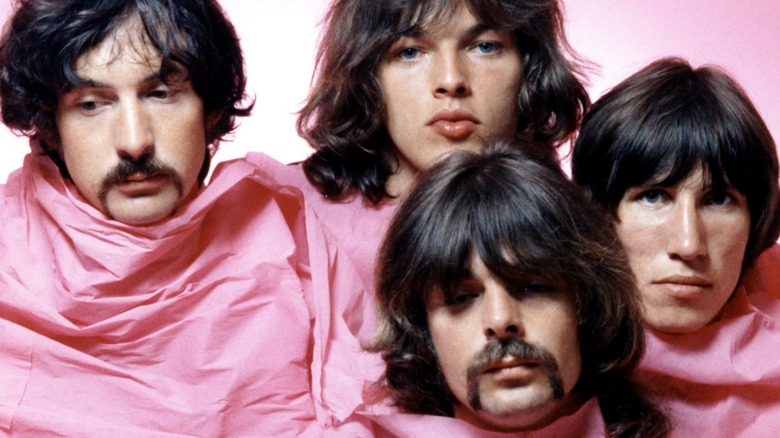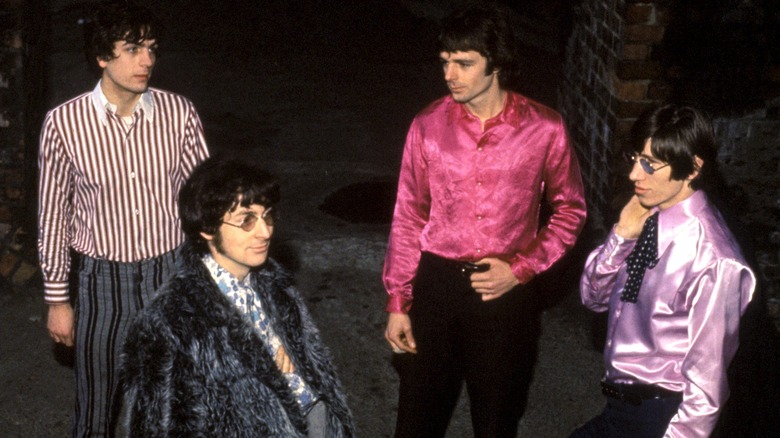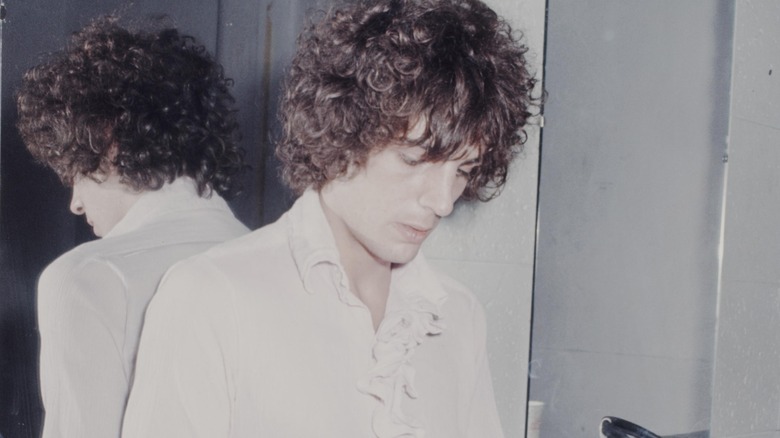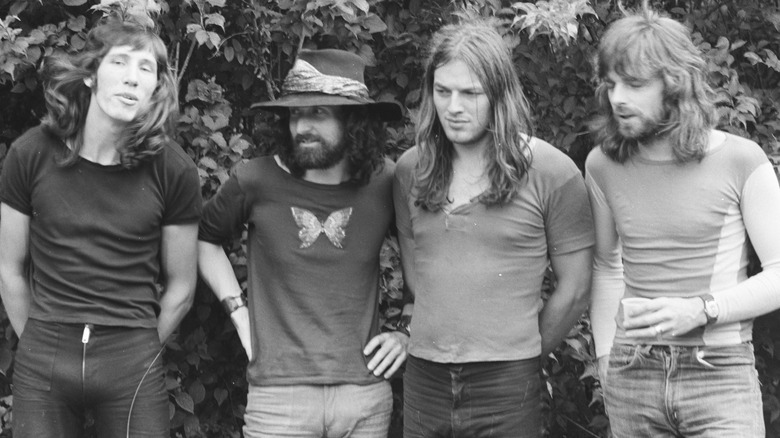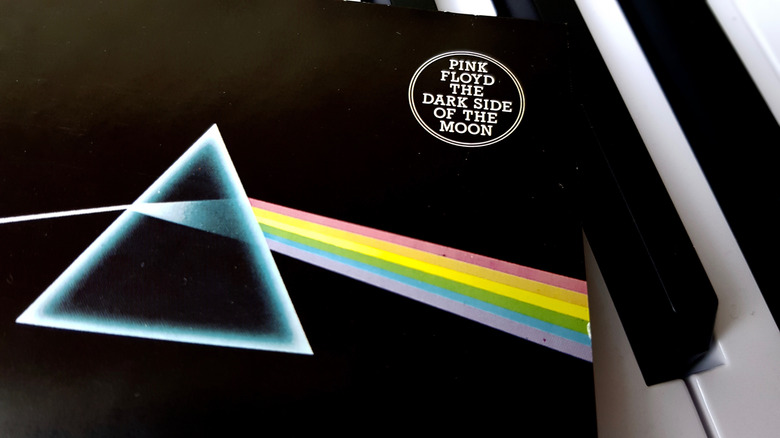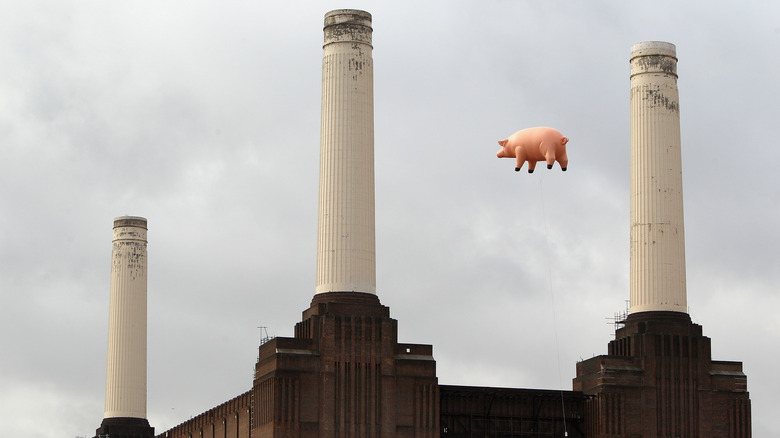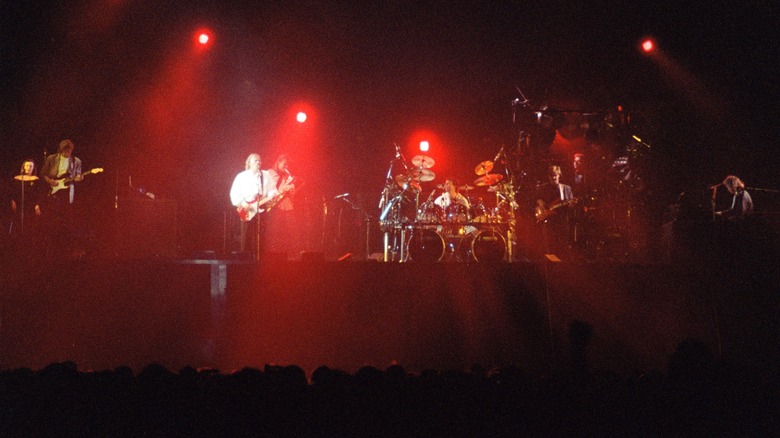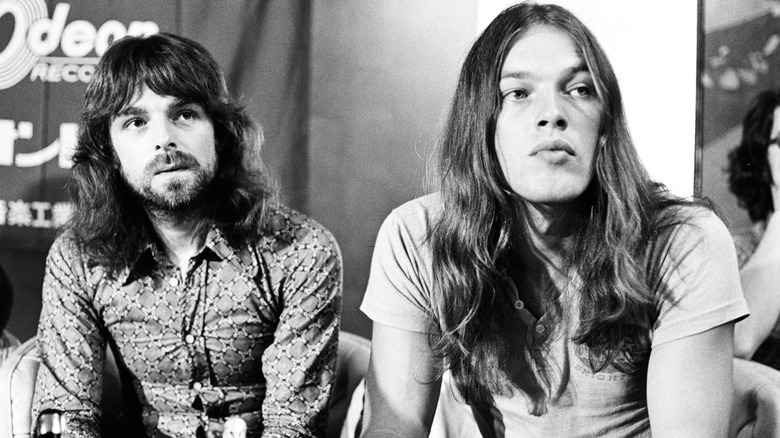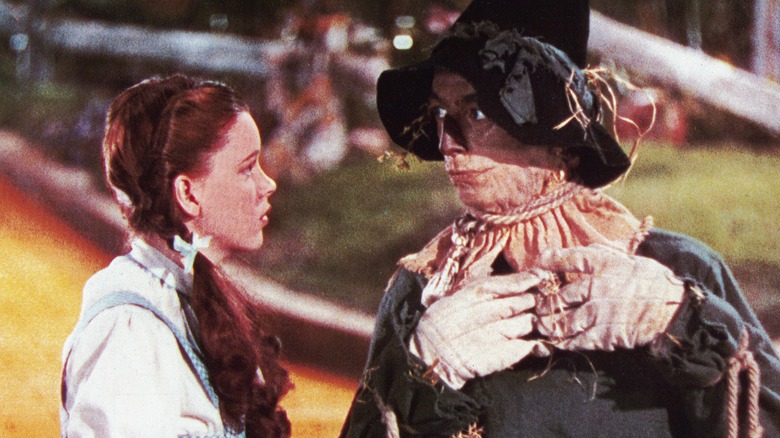The Untold Truth Of Pink Floyd
One of the most progressive rock bands of the '60s and '70s, Pink Floyd are legendary — and are still listened to by an entirely new generation. Per Britannica, although the band was initially influenced by "blues [and] music hall styles" thanks to founding member Syd Barrett, they pivoted to psychedelic rock before ultimately "[popularizing] the concept album for mass rock audiences."
According to Rolling Stone, it was actually Barrett who, along with bassist Roger Waters, formed the band in 1965 as they knew one another from studying at Cambridge. Soon enough, they brought on two more architecture students: Rick Wright on the organ and Nick Mason on drums. As revealed by Rolling Stone, these early years saw Barrett fueled with "passion" for the Beatles' "melodic form" while also gravitating towards the blues-pop sound he came to love from the Rolling Stones. It's then that he began experimenting with different techniques and sounds, thus giving birth to Pink Floyd's experimental edge.
After releasing "The Final Cut" in 1983, Pink Floyd — as fans know it — dissolved (via Britannica). Waters pursued a solo career, and although Wright, Mason, and David Gilmour (Barrett's replacement) reunited in the late '80s for two more albums, the group's legacy has been somewhat tainted due to the bitter, almost-40-year feud between Gilmour and Waters. However, disputes aside, there's no denying the colossal mark these rock stars have left on the music industry. This is the untold truth of Pink Floyd.
Ladies and gentlemen, The Tea Set
Pink Floyd performed under some pretty interesting names before settling on their famous moniker. As revealed by Far Out, the band tried their luck with The Megadeaths (not to be confused with the actual Megadeth who formed in the '80s), The Spectrum 5, The Screaming Abdabs, and another unique option: The Tea Set.
As Far Out points out, this latter option actually kind of made sense; after all, "it seemed to resonate with the band's Mad Hatter ethos" of the LSD-induced sonic adventures that Syd Barrett would start going on around this time (via Biography). Ultimately, however, the group decided to change the name yet again, and as "Echoes: The Complete History of Pink Floyd" points out, this was probably due to another London-based band that was utilizing the same handle.
So, why did the lads go for "Pink Floyd"? Well, the reason isn't exactly exciting. As "Echoes" explains, the change was "very spur-of-the-moment" due to a lack of better ideas, and it simply just stuck. It was Barrett who came up with the now-famous moniker due to his record collection: "Pink" came from Pink Anderson, while "Floyd" was from Floyd "Dipper Boy" Council — both Carolina-based blues artists. As Roger Waters famously quipped (via "Echoes"), "Anderson Council" was their other option, and "it would have sounded like a local authority."
Syd Barrett was afraid he would vanish
Would Pink Floyd have existed without Syd Barrett? The co-founding guitarist was crucial, having served as the primary writer for the group's debut album, "The Piper at the Gates of Dawn," in 1967 (via Rolling Stone). As Roger Waters gushed to Rolling Stone, "What was so stunning about Syd's songs was, through the whimsy and the crazy juxtaposition of ideas and words, there was a very powerful grasp of humanity." He poignantly added, "They were quintessentially human songs."
And yet, although Barrett's songs carried that grasp of humanity, he was slowly losing his grip on it, too. His unique ability to write imaginative songs was partially due to his "steady overconsumption of LSD," which ultimately led to a mental breakdown (via Biography). According to "Echoes," as Pink Floyd's success grew, Barrett began to feel the pressures of fame, causing him to "withdraw" from the non-stop work. Per Biography, after a year of bizarre and troubling behavior, Pink Floyd replaced Barrett with David Gilmour, and by April 1968, they "announced that Barrett was no longer a member of the band."
Syd Barrett attempted a solo career, giving his final interview as a musician to Rolling Stone in 1971. Hauntingly, he told the outlet, "I'm disappearing," with the mag noting that his eyes were now in "a permanent state of shock." Tragically, the guitarist faded into obscurity, moved back home to Cambridge where he mostly "kept to himself," ultimately dying from pancreatic cancer in 2006 (via Biography).
Was Shine On You Crazy Diamond a tribute to Syd Barrett?
Pink Floyd's ninth studio album, "Wish You Were Here," was released in September 1975, shooting straight to the top of the charts in the U.S. and the U.K., selling over 14 million copies globally (via Classic Rock). Interestingly enough, during the making of the album, the men had a visitor come into the studio: Syd Barrett.
As drummer Nick Mason revealed in the doc, "The Story of Wish You Were Here," none of the band members recognized Barrett, with David Gilmour adding that their once-handsome former band member had turned "balloon-shaped" and was without eyebrows or hair. Allegedly, both Gilmour and Roger Waters cried at the sight. On that album, Waters wrote the lyrics to "Shine On You Crazy Diamond" — a haunting tribute to their founding member. As Waters explained in "Comfortably Numb: The Inside Story of Pink Floyd" (via UCR), he rewrote the lyrics multiple times, trying to capture the "inevitable melancholy about the disappearance of Syd."
Interestingly enough, years later, in 2018, it looks like Waters may have retracted his earlier explanation of the song or, at least, elaborated on it. As he told Classic Rock, "'Shine On' is not really about Syd, he's just a symbol for the extremes of absence some people have to indulge in because it's the only way they can cope with how fu**ing sad it is – modern life – is to withdraw completely."
Dark Side of the Moon helped fund a now-cult-classic comedy
Pink Floyd's eighth album, "Dark Side of the Moon," is considered a rock classic. According to Billboard, it hit the charts on March 17, 1973, entering the Top 200. A remarkable 14 years later (exactly 736 weeks), "it finally fell off The Billboard 200." Along with a later appearance on the chart again, coupled with an additional 759 weeks on the Top Pop Catalog Album chart, this pop culture relic spent a stunning "1,500 weeks on the charts." Needless to say, it made the U.K. rockers a pretty penny.
Interestingly enough, "Dark Side of the Moon," as legendary as it is, is tied in with another British cult classic. Per Rolling Stone, while Pink Floyd was recording "Dark Side of the Moon," they spent their free time watching the comedy ensemble "Monty Python's Flying Circus." When it was time for the actors to shoot their first full-length feature film, they struggled to pony up the dough. Cue: Pink Floyd.
"None of [the movie studios] would give us any money," revealed director Terry Gilliam to The Guardian, explaining that at the time, "income tax was running as high as 90%." As such, they turned to some of the biggest names in the music biz. "Elton John, Pink Floyd, Led Zeppelin, they all had money, they knew our work and we seemed a good tax write-off," he noted. Ultimately, Pink Floyd gave "10 percent of the film's initial £200,000 budget" (via Rolling Stone).
George Orwell inspired an entire album
George Orwell's World War II-written novella, "Animal Farm," was an instant success, with the first edition selling out in a mere month (via Encyclopedia.com). The story revolves around a group of animals rebelling against the farmers that owned them — an allegory that warns against allowing totalitarians to have all complete political power. This classic tale also served as the inspiration for Pink Floyd's 1977 concept album, "Animals."
It wouldn't be the only time Pink Floyd took a bold social stance — after all, they would follow up with 1979's boisterous political commentary on "The Wall," yet "Animals" served as a stepping-stone for future concept album success. Coming in at only five songs, Roger Waters adapted Orwell's book into his lyrics and titles: "the pigs are the rulers, the dogs are the wannabe imperialists but nevertheless, they possess material wealth, and the sheep are on the bottom, the mindless followers" (via Far Out).
As Phil Rose points out in "Roger Waters and Pink Floyd: The Concept Albums," even the album cover of "Animals" holds significance to the point Waters is attempting to make: since the pigs are the rulers, a large inflatable swine is seen "suspended high above London's Battersea Power Station," which that in itself was once a "symbol" of power in industrial London.
Spitting on a fan led to Pink Floyd's album, The Wall
In 1977, Pink Floyd played at the Olympic Stadium in Montreal. According to the National Post, it was the largest "stadium rock concert in Canada," coming in at a whopping 80,000 unruly fans. Wayne Larsen of the Montreal Gazette was actually in that crowd, near the front. Recalling the very rowdy crowd, Larsen explains that "the mood was killed by loud belches and catcalls," followed up with fireworks — one of which "went off" close to Roger Waters' head.
"Aw, fer fu**'s sake," Waters allegedly yelped. "Stop lighting off fireworks," he screamed (via Montreal Gazette). Sure enough, the chaos didn't stop, and according to "several accounts," roadies ended up grabbing one of the firecracker culprits, "dragged him up to the stage and held him while Waters leaned in and spat" in his face. This Montreal concert was the last that the band played before recording "The Wall," and it served as a huge inspiration.
As Waters told the National Post in 2016, "What I think happened was that I was pissed off ... with all due respect to the population of Montreal, [they] were completely fu**ing drunk." Adding that reflecting about the moment, he realized he was "in the wrong," he couldn't shake off the fact that the incident didn't make him "feel human." As such, Waters came up with "The Wall," which he says "involved building a huge wall between me and the people that I was trying to communicate with.
The making of the movie, The Wall, was a disaster
The year 1982 saw the release of "Pink Floyd: The Wall," a movie based on the band's record of the same name, and one of the most celebrated albums of all time (via Rolling Stone). Roger Ebert dubbed it "the best of all serious fiction films devoted to rock," per RogerEbert.com, and the flick won two BAFTA awards the following year. Simply put, "Pink Floyd: The Wall" became a cult classic, so some fans may be surprised to hear just how difficult it was to get this movie finished.
"I'm very proud of it," declared the flick's director, Alan Parker, in an essay on his website, adding, "But the making of the film was too miserable an exercise." As it turned out, Parker's main difficulty came from singer-songwriter Roger Waters and Gerald Scarfe, the cartoonist who helped Waters create "the extravagant stage show of 'The Wall'" (via Louder Sound). As Parker himself explained, Waters' personality was "intimidating," especially when it came to suggesting anything outside his own personal vision for the movie, which caused tensions between himself and Scarfe. According to Far Out, the animator was "so distressed and anxious" about working on the project that he turned to drinking, usually seen with a flask of whiskey.
As Parker explains, he wouldn't see Waters for decades after the opening of the flick, while whenever he bumped into Scarfe, the cartoonist would "shudder." Eventually, he, too, would make amends with the director.
Pink Floyd performed at an ancient Roman amphitheater to no audience
The amphitheater found in the ancient Roman city of Pompeii once housed "up to 12,000 spectators" (via Pompeii Online) and was home to brutal gladiatorial fights, along with more light-hearted circus acts. When nearby Mount Vesuvius erupted in 79 AD, it wiped out the population of Pompeii, and the city hauntingly remained buried until the 1700s when it was rediscovered (via Britannica). Almost 300 years later, that very same amphitheater was the venue for probably one of the most bizarre concerts of all time: "Pink Floyd: Live at Pompeii."
As the director of the documentary, Adrian Maben, told Brain Damage, he chose Pompeii as the venue because of the "pleasant contradiction to play live in a place that is dead." Since Pink Floyd were to play to virtually no audience (save for the crew and some local children who snuck in), the idea to "resurrect" the dead city came to him in hopes to "imagine that ghosts of the past could somehow return."
The shots of empty Pompeii combined with Pink Floyd's melodies give a captivating result. As Maben told Prog, road manager Peter Watts "said the sound had a kind of echo to it," noting "that the Romans who built the amphitheater thought not only of the structure but also of the acoustic qualities." As David Gilmour said years later in 2015 (via Prog), "I don't think any of us thought it would ... last in people's minds for as long as it did."
They almost made an album entirely out of household objects
After the release of "Dark Side of the Moon" in 1973, Pink Floyd looked to create another experimental album: this time entirely out of household objects. Dubbed simply "Household Objects," this effort was supposed to bring the band back to their early, exploratory days, and as UCR explains, they felt "pressure" to deliver a successful follow-up after their "groundbreaking" previous record. Ditching their traditional instruments, Pink Floyd grabbed anything they could get their hands on, "including hand mixers, wine glasses, aerosol spray cans and rubber bands."
As keyboardist Richard Wright revealed in "Which One's Pink" (via UCR), the idea was Roger Waters', and they spent "weeks and weeks" trying to get the objects to sound like specific instruments. Finally, according to drummer Nick Mason in "Inside Out: A Personal History of Pink Floyd" (via Longreads), the band had to scrap the project, as they "could sustain the pretense no longer."
That being said, some of these experimental efforts did see the light of day. According to UCR, the sounds of the wine glasses being rubbed can be heard in the intro to "Shine On You Crazy Diamond" — a track on their actual follow up album, 1975's "Wish You Were Here."
Did Pink Floyd intend to follow the yellow brick road?
"Dark Side of the Moon" is undeniably Pink Floyd's greatest effort. According to "Speak to Me: The Legacy of Pink Floyd's The Dark Side of the Moon," with "upwards of 34 million units sold, [it's] the third most popular album of all time." Naturally, with so many people listening to it over the years, fans have tried analyzing it, while others have even started making bizarre connections to other works of art.
A viral 1995 article by The Fort Wayne Journal Gazette claimed that the band's eighth album synced up perfectly with 1939's fantasy classic, "The Wizard of Oz." As the article explains, "There exists a connection –- no, really a synchronicity –- between the two that escapes logic or understanding," with the lyrics allegedly matching the plot of the film, while the character's movements go perfectly with the music.
So, is there any truth to this now-popular claim? The answer is a disappointing no. As drummer Nick Mason bluntly told BBC1 in 2010 (via Brain Damage), he finds it "unthinkable" that Pink Floyd would have found a need to work with the film's leading star, Judy Garland; and create an album around "The Wizard of Oz." He added, "sadly, both the tin man, and the straw man, and all the rest of it, had absolutely zero to do with that particular record."
Pink Floyd and Facebook? Heck no!
Pink Floyd's "The Wall" was a counterculture anthem when it came out — both the album and the supporting flick that came out years later. In fact, there's even an analysis that came out on "The Wall," originally written in 1997. Looking at one of the album's songs, "Another Brick in the Wall, Part 2," the website notes that the message of the song is evident: "Oppression of any kind, whether personally or socially, leads to the death of individuality" — something that still rings true today.
Interestingly enough, in 2021, Instagram reached out to singer-songwriter Roger Waters to see if they could use "Another Brick in the Wall" for one of their ads. As CNET notes, Facebook bought Instagram in 2012, so Waters' understanding was that the app's founder, Mark Zuckerberg, was the one who had the idea to reach out. His answer? "F**k you!" As Waters explained during a press conference, he was offered a "huge amount of money," yet still refused to budge. "This is an insidious movement for them to take over absolutely everything," he explained, adding, "We feel that the core sentiment of this song is still so prevalent and necessary today."
Meanwhile, a Facebook rep told CNET that the band wasn't contacted by Zuckerberg and instead "from the Instagram marketing team."
Roger Waters' relationship with his bandmates is turbulent
The remaining members of Pink Floyd have famously feuded for years. Things have gotten so bad, in fact, that the Independent dubbed it "The greatest feud in rock." So, what exactly happened?
In 1983, Pink Floyd released "The Final Cut," the band's last album which featured founding member Roger Waters. Willie Christie, the photographer behind the album art, explained that a "break up was on the horizon" (via Louder Sound), with both David Gilmour and Waters finding the recording process "very tough," and butting heads, in the process. According to Rolling Stone, Waters famously left the band in favor of a solo career in 1985, under the impression that Pink Floyd as fans knew it would dissipate. That wasn't the case, and in 1987, Pink Floyd (without Waters) released "A Momentary Lapse of Reason" — but it didn't come without hardship.
Per Louder Sound, the bassist sued his former bandmates in 1985 "to prevent the Pink Floyd name ever being used again." According to the BBC, he declared that the band was "a spent force creatively." The battle lasted two years, was finally settled out of court, yet tensions stuck for years, with the remaining members eventually reuniting on stage decades later. Finally, in 2013, Waters admitted to BBC's "HARDtalk," that he was "wrong," adding, "Of course I was. Who cares?"
